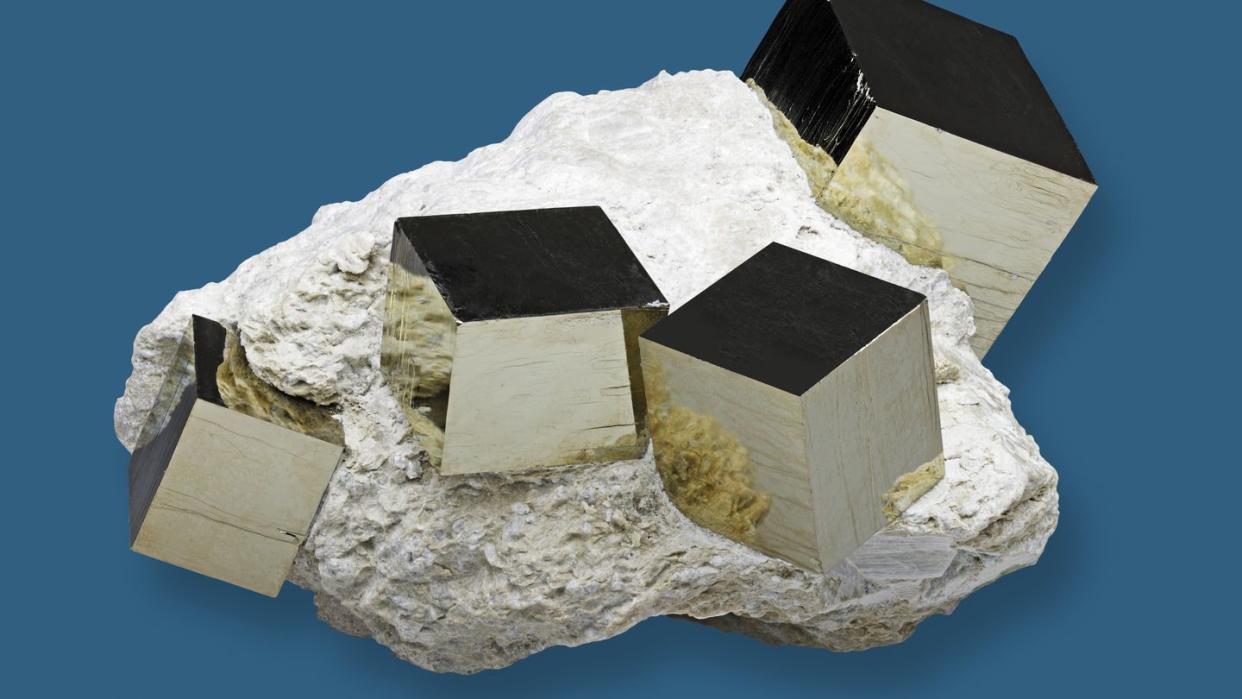We Used to Make Fun of Fool's Gold. Now, It Might Fuel Our Future.

Lithium is steadily becoming the most important element for the future, as its found in smartphones, laptops, electric cars, and is even central to future tech like nuclear fusion reactors.
However, extracting lithium has many costs—both financial and environmental—so it’s big news that a new study suggests that pyrite (a.k.a. fool’s gold) could be a potential source of lithium.
While this pyrite/lithium interaction isn’t well understood, it could mean that past and present oil and gas operations could paradoxically be a source of the very mineral that aims to replace those greenhouse gas-spewing fuels.
Lithium is one of the most important elements on the periodic table. Because it’s lightweight and easily gains and loses ions, the material is central to the batteries that power almost everything in our technological world.
But lithium’s importance doesn’t stop at your iPhone. Lithium-6 (an isotope of the soft metal) is crucial for breeding tritium, which is the hydrogen isotope that lies at the heart of nuclear fusion. It’s for these reasons—as well as the burgeoning EV revolution and the desperate need for green energy battery storage—that the U.S. government considers lithium (also referred to as “White Gold”) a critical mineral.
In other words, the world runs on lithium.
But for all of its amazing benefits, lithium has some major downsides. For one, its highly reactive nature means that most lithium-ion batteries are essentially just controlled bombs—hence the long lines at airport security. It also isn’t easy to extract, as it’s often locked away in igneous rock and saltwater brine.
The world is hungry for more sources of lithium, and a new study from the Isotopic and Biogeochemical Characterization of Geological Materials (IsoBioGeM) laboratory at the University of West Virginia recently stumbled across another kind of “gold” that could be an “unheard of” source for this precious mineral—pyrite, or known by its more derogatory nickname, “fool’s gold.”
After analyzing 15 sedimentary rock samples in the Appalachian basin dating from the middle-Devonian nearly 400 million years ago, what the scientists found surprised them. Within the pyrite minerals in shale were sources of lithium. This means that the organic-rich shale could have higher concentrations of lithium than previously believed due to little-known interactions between lithium and pyrite. The scientists presented their findings on Monday at the EGU General Assembly 2024.
“These initial findings suggest that pyrite in conjunction with organic matter may play a previously unrecognized role in the Li distribution in organic-rich shales,” the study’s abstract reads. “The geochemical processes that might cause Li enrichments associated with pyrite are not well-understood…[but] using material from previous industrial operations (e.g., mine tailings or drill cuttings) as a source of additional Li would be attractive as it would generate little or no new waste material.”
While finding a potentially new source of a lithium is certainly exciting, this particular method would also be a very green option. Starting up new lithium mines costs a lot—in time, money, and environmental degradation—so extracting lithium from past and present oil and gas operations could help make the transition from those very greenhouse gas-producing fossil fuels even easier. That’s because industrial mining operations, especially mine tailings and drill cuttings, could contain leftover lithium deposits in the pyrite minerals left behind in the shale.
Demeaned for centuries, pyrite is now ready to accept your apology.
You Might Also Like
